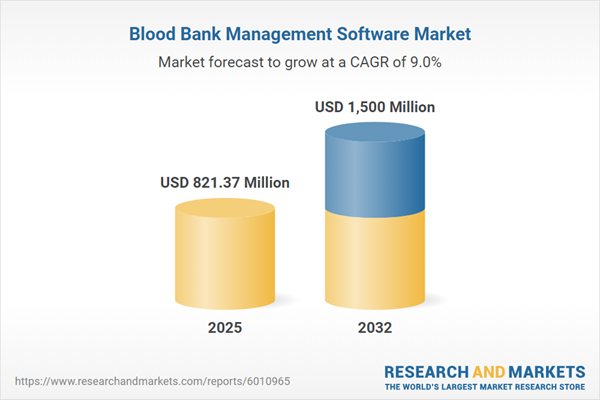Speak directly to the analyst to clarify any post sales queries you may have.
The Blood Bank Management Software Market is undergoing transformative growth as healthcare leaders increasingly seek digital solutions to drive operational efficiency, maintain regulatory compliance, and enable scalable workflows. These platforms provide actionable insights and systematic oversight—vital for senior decision-makers shaping next-generation blood bank strategies.
Market Snapshot: Blood Bank Management Software Market Trends and Growth
The Blood Bank Management Software Market is expanding as persistent healthcare digitization strengthens demand for advanced donor management and workflow automation. Significant investments from healthcare providers reflect a heightened focus on secure digital recordkeeping, agile compliance tools, and automation frameworks that support complex operational environments. The evolution of customizable software platforms has enabled enhanced traceability, real-time inventory control, and scalable deployments. Meeting the varying levels of digital maturity across regions, organizations in both developed and emerging markets leverage these solutions to optimize blood supply chain management while adapting to new healthcare technology standards.
Scope & Segmentation
- Component: Modern solutions offer donor management tools, provide real-time inventory visibility, and integrate smoothly with laboratory and clinical systems. Service elements include technical support, implementation consulting, and training to reinforce workflow reliability.
- Deployment Mode: Cloud models—private, public, or hybrid—support flexible adaptation and reduce in-house maintenance. On-premise configurations appeal to organizations seeking direct data oversight and robust internal compliance.
- End User: The market addresses needs for independent blood banks, government transfusion centers, and hospital networks, tailoring capabilities to specific operational and compliance expectations in each segment.
- Organization Size: Modular software platforms enable customization to support both small-scale healthcare providers and large hospital enterprises, aligning performance and cost-effectiveness with organizational size.
- Application: Core applications span donor engagement, automated inventory management, laboratory workflow optimization, and full traceability throughout transfusion and resource distribution channels, strengthening end-to-end healthcare supply chains.
- Regional Scope: Solutions are tailored for the Americas, Europe, Asia-Pacific, and Middle East & Africa. Each region benefits from adaptation to local procurement strategies, regulatory environments, and varying levels of digital advancement.
- Key Companies: Leading industry players—Oracle Corporation, Epic Systems, Haemonetics, WellSky, MEDITECH, Allscripts Healthcare Solutions, SCC Soft Computer Consultants, Becton Dickinson, Siemens, and InterSystems Corporation—continue to enhance platform security, resilience, and feature sets across critical market segments.
Key Takeaways for Senior Decision-Makers
- Integrated digital workflows enhance collaboration among clinical, operational, and administrative teams, creating pathways for greater transparency and oversight through real-time reporting.
- Adopting cloud-first infrastructure helps organizations centralize management, streamline scaling, and simplify resource deployment across multiple sites or regional hubs.
- AI-driven analytics provide predictive resource planning and support measurable process improvements, equipping leadership with robust data for informed portfolio decisions.
- Modern compliance tools minimize audit risks and support proactive adaptations as global and regional regulatory frameworks evolve.
- Market adoption patterns differ: mature healthcare systems favor comprehensive platforms, while fast-growing regions focus on modular mobile solutions to accelerate digital transformation.
- Strong collaboration between vendors and healthcare organizations ensures that software innovation continues to align with clinical best practices and policy updates.
Tariff Impact: Navigating US Policy Shifts
Adjustments in US tariffs have caused healthcare providers using hardware-dependent blood bank systems to reassess cost structures and operational logistics. This landscape is accelerating the transition towards cloud and hybrid software models, improving expenditure predictability and organizational agility as policy and supply chain conditions evolve.
Methodology & Data Sources
This market evaluation is grounded in direct executive interviews supported by thorough analysis of reputable secondary sources. The involvement of industry domain experts ensures that the findings accurately reflect real modernization drivers and operational practices governing today's blood bank software market.
Why This Report Matters
- Offers actionable segmentation and use-case insights, supporting strategic modernization and efficient resource management in varied healthcare settings.
- Equips procurement, compliance, and IT transformation teams with targeted recommendations for smoother transitions and robust due diligence.
- Enables senior leaders to better plan for regulatory and supply chain shifts, fostering sustained operational resilience and long-term organizational success.
Conclusion
Strategic implementation of blood bank management software is essential for maintaining agility and compliance across healthcare organizations. This report guides decision-makers through selecting adaptable digital solutions that support future-focused operations and regulatory integrity.
Additional Product Information:
- Purchase of this report includes 1 year online access with quarterly updates.
- This report can be updated on request. Please contact our Customer Experience team using the Ask a Question widget on our website.
Table of Contents
3. Executive Summary
4. Market Overview
7. Cumulative Impact of Artificial Intelligence 2025
Companies Mentioned
The companies profiled in this Blood Bank Management Software market report include:- Oracle Corporation
- Epic Systems Corporation
- Haemonetics Corporation
- WellSky Corporation
- Medical Information Technology, Inc.
- Allscripts Healthcare Solutions, Inc.
- SCC Soft Computer Consultants, Inc.
- Becton, Dickinson and Company
- Siemens AG
- InterSystems Corporation
Table Information
| Report Attribute | Details |
|---|---|
| No. of Pages | 182 |
| Published | October 2025 |
| Forecast Period | 2025 - 2032 |
| Estimated Market Value ( USD | $ 821.37 Million |
| Forecasted Market Value ( USD | $ 1500 Million |
| Compound Annual Growth Rate | 9.0% |
| Regions Covered | Global |
| No. of Companies Mentioned | 11 |









